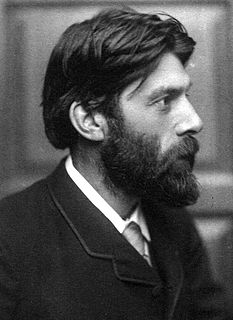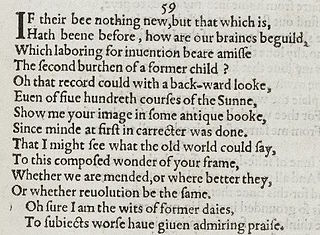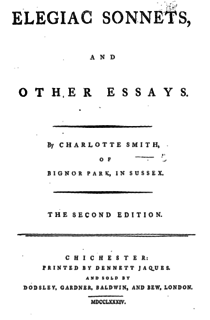Related Research Articles

Gerard Manley Hopkins was an English poet and Jesuit priest, whose posthumous fame established him among the leading Victorian poets. His manipulation of prosody – particularly his concept of sprung rhythm – established him as an innovative writer of verse, as did his technique of praising God through vivid use of imagery and nature. Only after his death did Robert Bridges begin to publish a few of Hopkins's mature poems in anthologies, hoping to prepare the way for wider acceptance of his style. By 1930 his work was recognised as one of the most original literary accomplishments of his century. It had a marked influence on such leading 20th-century poets as T. S. Eliot, Dylan Thomas, W. H. Auden, Stephen Spender and Cecil Day-Lewis.

Poetry is a form of literature that uses aesthetic and often rhythmic qualities of language—such as phonaesthetics, sound symbolism, and metre—to evoke meanings in addition to, or in place of, the prosaic ostensible meaning.
Sprung rhythm is a poetic rhythm designed to imitate the rhythm of natural speech. It is constructed from feet in which the first syllable is stressed and may be followed by a variable number of unstressed syllables. The British poet Gerard Manley Hopkins said he discovered this previously unnamed poetic rhythm in the natural patterns of English in folk songs, spoken poetry, Shakespeare, Milton, et al. He used diacritical marks on syllables to indicate which should be stressed in cases "where the reader might be in doubt which syllable should have the stress" and which syllables should be pronounced but not stressed.

A sonnet is a poetic form which originated in the Italian poetry composed at the Court of the Holy Roman Emperor Frederick II in Palermo, Sicily. The 13th-century poet and notary Giacomo da Lentini is credited with the sonnet's invention for expressing courtly love. The Sicilian School of poets who surrounded him at the Emperor's Court are credited with its spread. The earliest sonnets, however, no longer survive in the original Sicilian language, but only after being translated into Tuscan dialect.
Elizabeth (Joan) Jennings was an English poet.

Robert Seymour Bridges was an English poet who was Poet Laureate from 1913 to 1930. A doctor by training, he achieved literary fame only late in life. His poems reflect a deep Christian faith, and he is the author of many well-known hymns. It was through Bridges' efforts that Gerard Manley Hopkins achieved posthumous fame.
In modern literary criticism, more common with genre fiction, conceit often means an extended rhetorical device, summed up in a short phrase, that refers to a situation which either does not exist, or exists rarely, but is needed for the plot.

This article focuses on poetry from the United Kingdom written in the English language. The article does not cover poetry from other countries where the English language is spoken, including Southern Ireland after December 1922.
The curtal sonnet is a form invented by Gerard Manley Hopkins, and used in three of his poems.
The following outline is provided as an overview of and introduction to poetry:

Sonnet 59 is one of 154 sonnets written by the English playwright and poet William Shakespeare. It's a part of the Fair Youth sequence, in which the poet expresses his love towards a young man.

Milton's 1645 Poems is a collection, divided into separate English and Latin sections, of John Milton's youthful poetry in a variety of genres, including such notable works as An Ode on the Morning of Christ's Nativity, Comus and Lycidas. Appearing in late 1645 or 1646, the octavo volume, whose full title is Poems of Mr. John Milton both English and Latin, compos'd at several times, was issued by the Royalist publisher Humphrey Moseley. In 1673, a year before his death, Milton issued a revised and expanded edition of the Poems.

The sonnets of Petrarch and Shakespeare represent, in the history of this major poetic form, the two most significant developments in terms of technical consolidation—by renovating the inherited material—and artistic expressiveness—by covering a wide range of subjects in an equally wide range of tones. Both writers cemented the sonnet's enduring appeal by demonstrating its flexibility and lyrical potency through the exceptional quality of their poems.
"Adoro te devote" is a Eucharistic hymn written by Thomas Aquinas. It is one of the five Eucharistic hymns which were composed and set to music for the Solemnity of Corpus Christi, instituted in 1264 by Pope Urban IV as a Solemnity for the Latin Church of the Catholic Church.
"Pied Beauty" is a curtal sonnet by the English poet Gerard Manley Hopkins (1844–1889). It was written in 1877, but not published until 1918, when it was included as part of the collection Poems of Gerard Manley Hopkins.
"The Windhover" is a sonnet by Gerard Manley Hopkins (1844–1889). It was written on 30 May 1877, but not published until 1918, when it was included as part of the collection Poems of Gerard Manley Hopkins. Hopkins dedicated the poem "to Christ our Lord".
Sonnets on Eminent Characters or Sonnets on Eminent Contemporaries is an 11-part sonnet series created by Samuel Taylor Coleridge and printed in the Morning Chronicle between 1 December 1794 and 31 January 1795. Although Coleridge promised to have at least 16 poems within the series, only one addition poem, "To Lord Stanhope", was published.
In romantic literature, a work has organic form if the structure has originated from the materials and subjects used by the author. Using the organic metaphor, the structure is seen to grow as a plant. It stands in contrast to a mechanical form, a work which has been produced in accordance with artificial rules. The lack of rules in Shakespeare's works led some critics to claim that they lacked form; Samuel Taylor Coleridge leapt to his defence with the concept of organic form.
Inscape and instress are complementary and enigmatic concepts about individuality and uniqueness derived by the poet Gerard Manley Hopkins from the ideas of the medieval philosopher Duns Scotus. Inscape has been rendered variously as: external design, aesthetic conception, intrinsic beauty, the intrinsic form of a thing, a form perceived in nature, the individual self, the expression of the inner core of individuality, the peculiar inner nature of things and persons, expressed in form and gesture, and an essence or identity embodied in a thing. These twin concepts are what his most famous poems are about.
[Hopkins] felt that everything in the universe was characterized by what he called inscape, the distinctive design that constitutes individual identity. This identity is not static but dynamic. Each being in the universe 'selves,' that is, enacts its identity. And the human being, the most highly selved, the most individually distinctive being in the universe, recognizes the inscape of other beings in an act that Hopkins calls instress, the apprehension of an object in an intense thrust of energy toward it that enables one to realize specific distinctiveness. Ultimately, the instress of inscape leads one to Christ, for the individual identity of any object is the stamp of divine creation on it.

Elegiac Sonnets, titled Elegiac Sonnets, and Other Essays by Charlotte Sussman of Bignor Park, in Sussex in its first edition, is a collection of poetry written by Charlotte Turner Smith, first published in 1784. It was widely popular and frequently reprinted, with Smith adding more poems over time. Elegiac Sonnets is credited with re-popularizing the sonnet form in the eighteenth century. It is notable for its poetic representations of personal emotion, which made it an important early text in the Romantic literary movement.
References
- ↑ Alfie, Fabian (2017). The Poetry of Burchiello Deep-fried Nouns, Hunchbacked Pumpkins, ad other Nonsense. Tempe, Arizona: The Arizona Center for Medieval & Renaissance Studies. p. 26. ISBN 978-0-86698-550-5.
- ↑ Martín, Adrienne Laskier. "Cervantes and the Burlesque Sonnet". UC Press E-Books Collection. University of California Press. Retrieved 15 July 2021.
- ↑ "Caudate sonnet," The New Princeton Encyclopedia of Poetry and Poetics. Ed. Alex Preminger and T.V.F. Brogan. Princeton UP, 1993.
- ↑ See the introduction and notes to "Heraclitean Fire" in The Poems of Gerard Manley Hopkins, 4th edition, ed. W.H. Gardner and N.H. Mackenzie (Oxford UP, 1967).
- ↑ Jennifer A. Wagner, "The Allegory of Form in Hopkins's Religious Sonnets," Nineteenth-Century Literature, Vol. 47, No. 1. (Jun., 1992), 44-45.
- ↑ See Wagner (45), who quotes Barbara Herrnstein Smith on the effect of the form.